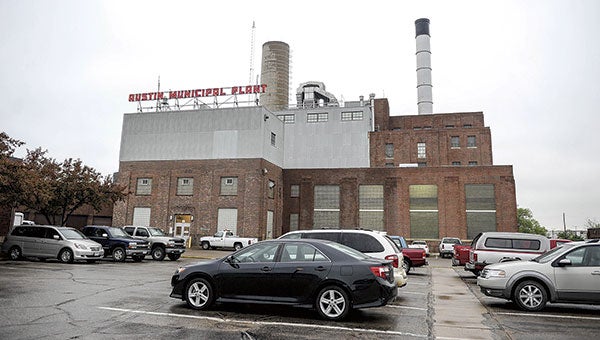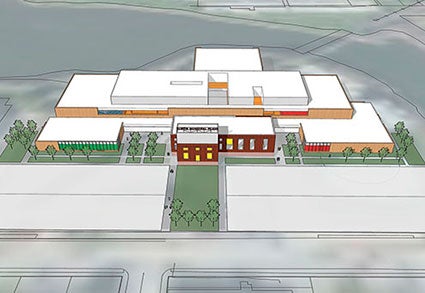‘Found common ground’ – Recreation Center proposal takes step closer to approval
Published 10:15 am Tuesday, May 17, 2016

The Austin City Council voted 5-2 to pass the proposals for the Rec Center onto the next regular meeting. Eric Johnson/photodesk@austindailyherald.com
A week after negotiations were said to be at an impasse, the Austin City Council preliminarily approved the $35 million Austin Community Recreation Center project, moving it forward to a regular council meeting on June 6.
The Austin City Council voted 5-2 to approve a lease agreement and conditional use agreement at a work session Monday night with Council members Michael Jordal and Jeremy Carolan voting “no.”
If approved by the same vote at the regular meeting, the city will acquire the former downtown Austin Municipal Plant as the home of the community rec center, which would feature public spaces and a new YMCA.
“I think it’s going to draw people to Austin,” Austin Mayor Tom Stiehm said, calling it the flagship Vision 2020 project.
Council members Dave Hagen and Janet Anderson agreed.
“I think we ironed out all our differences and came to a very good conclusion,” Hagen said.
“There were some tense moments here and there but I think it’s a very good outcome,” Anderson added.
Just last week, city officials and YMCA leaders differed over daily passes to access the facility, as YMCA leaders offered an $8 all-access pass, which would only be available four times throughout the year before a person is expected to become a monthly YMCA member, which city leaders questioned.
But Assistant City Attorney Craig Byram said the differences were ironed out when the city and YMCA officials agreed upon an all-access day pass for $12.50 and an aquatic daily pass rate for $8, both with no limits to the number of visits.
“This project presents a very unique confluence of interests,” Byram said. “On one hand, there’s a significant amount of benefit to the public by having the private sector entity like the YMCA provide management and operational responsibility for the facility, as opposed to having the public sector having additional employees.”
Another compromise included reducing the Youth Activity Center from 6,305 to 5,000 square feet, along with changes to the schedule of the YAC and the schedule of the aquatic center.
Now, the YAC will share the bathrooms with the common space and the community learning kitchen spaces can be used for other activities.
“We also want to make sure when it’s constructed it matches our imaginations and community and Y’s imaginations, so we know we are getting something truly useful for that purpose of the YAC,” Byram said. “That’s why it’s important to have mininum standards here, but we had to make sure we were speaking the same language. We found common ground at 5,000 square feet and met everyone’s interest.”
The schedule for the YAC is similar to other facilities in the area. It has to be open a minimum of 32 hours per week from the last week in September to mid-April. Other stipulations include activities such as game tables, computer area for homework, free popcorn, supervisors to conduct semi-organized activities, teaching students how to make healthy snacks and special event nights during the summer months.
“It’s our perception that this schedule as it is now, still meets the likely use patterns that Austin youth have used similar types of facilities in the past, which was important criteria for us,” Byram said.
The aquatic center schedule will be based on the YMCA’s current schedule. During school months, September to May, it will be open a minimum of 10 hours per day. Summer hours are reduced because it’s likely the outdoor pool will be utilized more.
Residents outside of Austin and visitors to the facility will likely pay a 25 percent increase of the daily fees, which would add up to about $10 for the aquatic center and $15.63 for the all-access pass.
“[We want to] make sure Austin has the advantage on the rates,” Byram said.
The remainder of items in dispute on the lease agreement include a lot of legal jargon and wording, but Byram said they were necessary for insurance and other purposes to protect both the city and YMCA.
Council member Jeremy Carolan asked if it was possible to reduce the daily rate fee in the future. Byram said it would be because in the lease agreement, city and YMCA officials are required to get together annually and discuss keeping a balance between the public’s interest in affordability and the Y’s interest in preserving membership rates to stay in business.
“If the Y goes out of business, we go out of business,” Stiehm said.
Council member Michael Jordal asked about potential traffic issues on Fourth Avenue Northeast. Public Works Director Steven Lang said there were likely three options to mitigate the traffic on Fourth Avenue Northeast, though they would still need to run the traffic study.
One was to add two bump-outs and a crosswalk near the facility, which would cost about $25,000 to $30,000. A second option was adding a signal light at Fourth Street and Fourth Avenue Northeast, which could cost about $200,000. The third option was to reconstruct the corridor, which would be expensive, but Lang added the road is a state aide road, so funding might be available.






